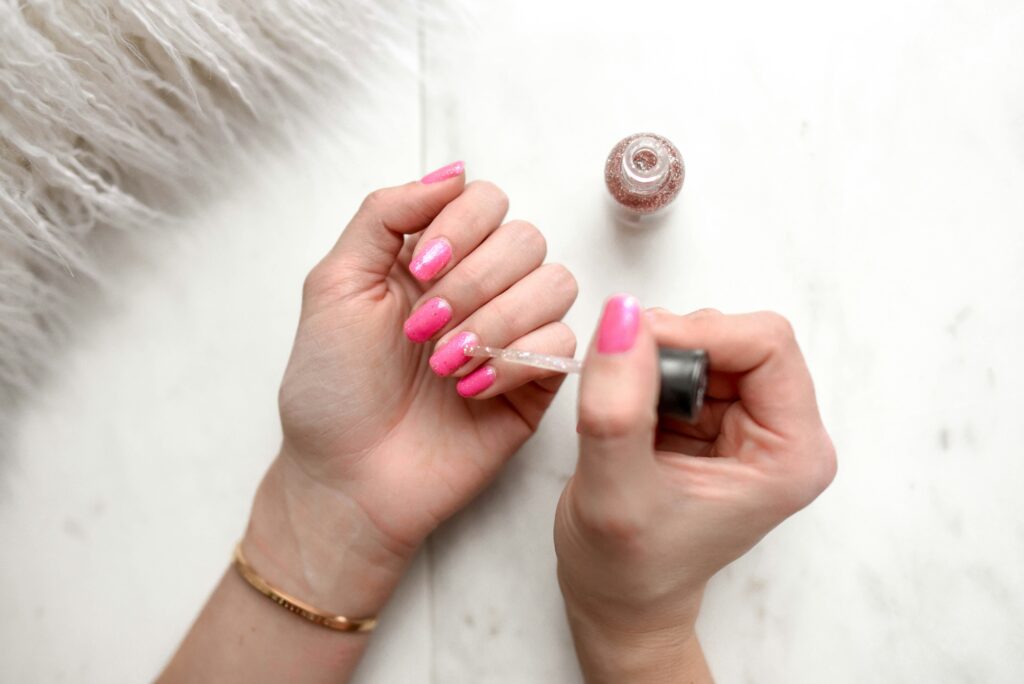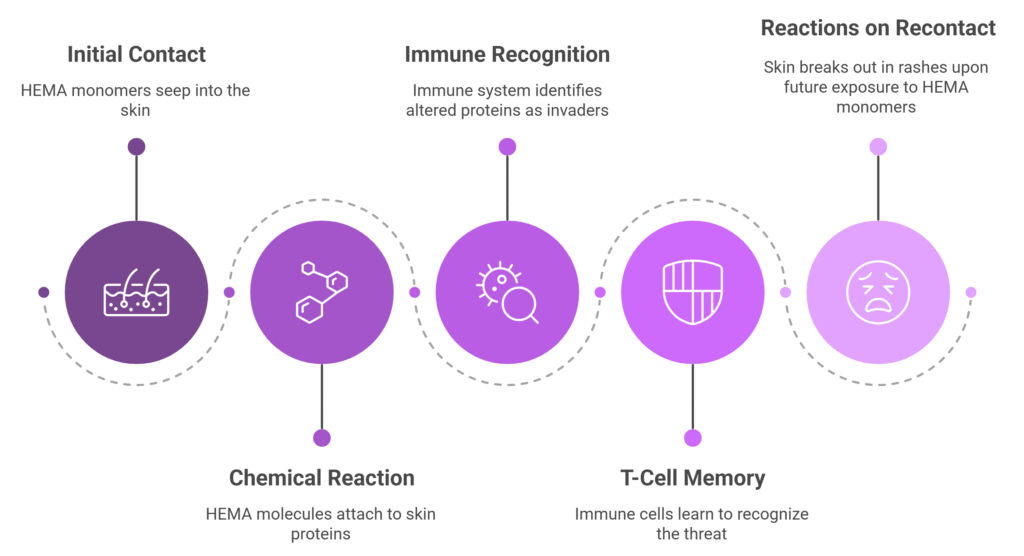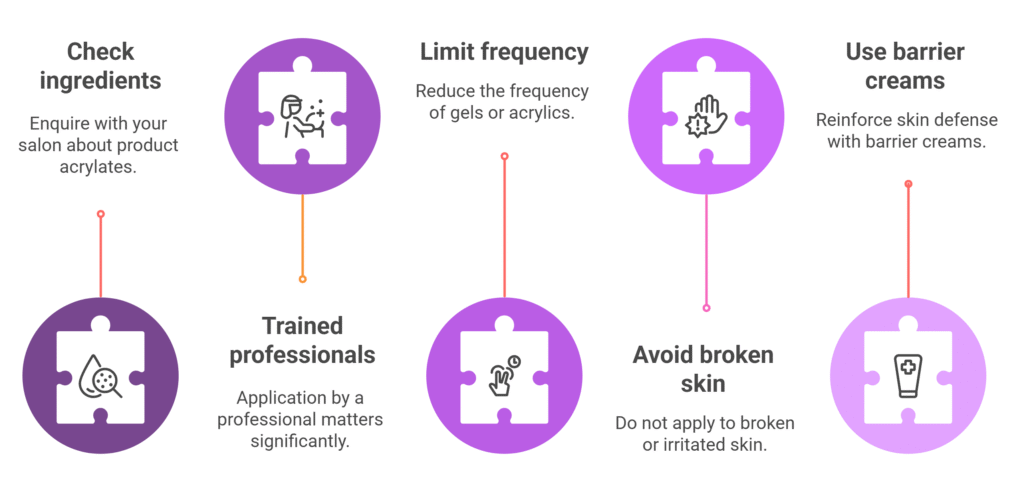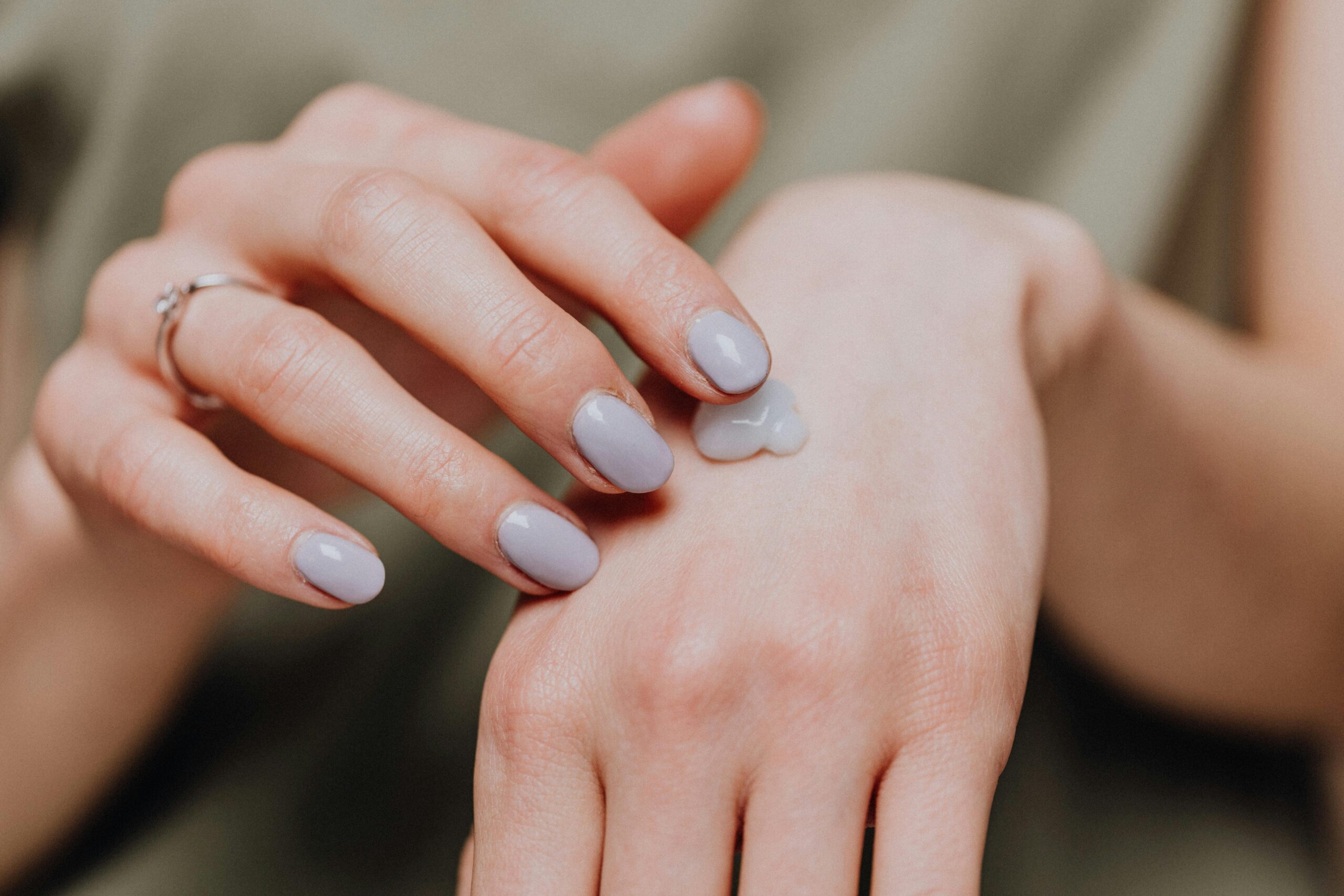Risks of Gel Manicure Allergies You Might Be Overlooking
If you’ve experienced red, itchy fingertips, eyelid swelling, or even a rash around your neck or face after a manicure, you’re not alone. More people are reporting symptoms of gel manicure allergy—an increasingly common form of allergic contact dermatitis (ACD) triggered by ingredients in gel and acrylic nail products. And it’s not just happening in salons. Home kits, often marketed as “easy DIY beauty,” may be quietly increasing your risk of sensitization.
At DrBeautiology, we believe beauty should feel good and do good for your skin. So we’re breaking down what science says about nail cosmetics, sensitization, and how to protect yourself—without ditching your self-care rituals.
- Risks of Gel Manicure Allergies You Might Be Overlooking
- What’s Really in Your Gel Manicure? Acrylates, Monomers & Modern Allergens
- How Sensitization Happens: The Allergy You Didn't See Coming
- Symptoms & Misdiagnoses: It’s Not Always Where You Expect It
- Nail Techs at Risk: The Hidden Cost of a Beautiful Career
- Patch Testing: Your Diagnostic Crystal Ball
- Hypoallergenic? Not Always What It Seems
- More Than Just a Gel Manicure Allergy: The Other Risks You Should Know
- Keep the Manicure, Skip the Rash: Smart Ways to Prevent Gel Manicure Allergy
- Final Thoughts: Educated Beauty Is Safer Beauty
- Join the Conversation
What’s Really in Your Gel Manicure? Acrylates, Monomers & Modern Allergens
Why Gel Manicures Are Different
Traditional nail polish works by drying through evaporation. But gel manicures rely on a chemical reaction called polymerization, where liquid ingredients (called monomers) harden into a plastic-like shell under UV or LED light.
These monomers—particularly a group called (meth)acrylates—act as powerful adhesives, helping your gel manicure stay chip-resistant and long-lasting. But there’s a downside: they’re also one of the main culprits behind gel manicure allergy, especially when they come into direct contact with your skin.
The Main Offenders: What Ingredients Should You Know?
According to dermatology research (Calado et al., 2021; Arora & Tosti, 2017), several monomers commonly found in gel and acrylic nail products have high allergenic potential:
| Ingredient | Function | Allergenic Risk Level |
| HEMA (Hydroxyethyl Methacrylate) | Helps polish adhere to the nail | Very high |
| HPMA (Hydroxypropyl Methacrylate) | Found in UV-curable systems | High |
| EGDMA (Ethylene Glycol Dimethacrylate) | Adds strength and hardness | High |
| TREGDA (Triethylene Glycol Diacrylate) | Improves texture and bonding | Moderate to high |
| MMA (Methyl Methacrylate) | Used in some acrylic systems (banned in many places) | Severe allergy risk and systemic effects |
HEMA, in particular, is one of the most common triggers of gel manicure allergy. It’s now included in many international patch test kits because of how frequently it causes sensitization. Once your immune system flags HEMA as a threat, it can start reacting not just to nail products, but also to other sources—like dental fillings, surgical adhesives, and even some medical tapes.
What does this mean for you? Even one exposure to uncured or improperly applied gel polish can lead to lifelong sensitivity. That’s why the way a product is applied (or misapplied) is just as important as the ingredients themselves.

What does this mean for you? Even one exposure to uncured or improperly applied gel polish can lead to lifelong sensitivity.
That’s why the way a product is applied (or misapplied) is just as important as the ingredients themselves.
How Sensitization Happens: The Allergy You Didn’t See Coming
Allergic contact dermatitis doesn’t happen immediately. It develops over time, and often by the time you notice symptoms, your immune system has already flagged the allergen as a threat.
Here’s how it works:
- Initial Contact: Monomers like HEMA seep into the skin—usually around the nails or fingertips.
- Chemical Reaction: These molecules attach to skin proteins, changing their structure.
- Immune Recognition: Your immune system mistakes the altered proteins for invaders.
- T-Cell Memory: Special immune cells “learn” to recognize this threat.
- Reactions on Recontact: On future exposure, your skin breaks out in red, itchy, or blistering rashes—even if it’s a tiny amount.

Why DIY Kits Are Riskier
At-home gel manicure kits may not provide the proper tools to fully cure the polish. If the light is too weak or the curing time is too short, some of the monomers don’t harden completely. These leftover chemicals can stay on your skin, increasing the risk of allergy.
What the books say: Experts stress that poor polymerization in DIY kits is a key driver of skin exposure. Professional-grade tools cure more consistently, which is why trained application matters.
Pro Tip: If you do your own gel nails, use a lamp that matches your product’s wavelength and cure time exactly. And avoid applying polish if your nails or surrounding skin are damaged—this increases permeability.
Symptoms & Misdiagnoses: It’s Not Always Where You Expect It
You might assume a reaction to nail polish would stay on your nails. But one of the tricky things about acrylate-induced dermatitis is how it often shows up far from the hands.
Common Symptoms on the Hands:
- Red, itchy cuticles
- Pulpitis (pain and inflammation at the fingertips)
- Peeling or cracked skin around the nails
- Onycholysis (nails lifting from the nail bed)
- White streaks or spots in the nail from repeated irritation
Distant-Site Reactions
- Eyelid swelling
- Facial eczema, especially around the mouth or nose
- Neck or chest rashes
These are often caused by hand-to-face transfer or airborne particles that settle on the skin during filing or curing.
Real-world example: In one case from Arora & Tosti, a woman using a gel kit at home developed swelling in her lips and a rash around her eyes. Her nails looked fine, but her patch test showed a strong reaction to HEMA and EGDMA.
Why It Gets Missed
Because the symptoms mimic other skin conditions—like eczema or rosacea—a gel manicure allergy caused by acrylates often goes undiagnosed, especially when the connection to nail products isn’t immediately clear.
Key takeaway: If you’ve noticed unexplained rashes that coincide with getting your nails done, it’s worth asking your dermatologist about patch testing for acrylates.
Nail Techs at Risk: The Hidden Cost of a Beautiful Career
While most consumers use nail products occasionally, nail technicians handle them daily. The result? They face a much higher risk of developing both skin and respiratory issues.
What the Research Shows
- 47.1% of nail professionals in one multicenter study tested positive for acrylate allergies (Arora & Tosti, 2017).
- In some salons, air samples revealed formaldehyde and methacrylate levels above legal safety limits.
Common Reactions Among Nail Professionals:
- Chronic hand eczema (from handling uncured product)
- Facial dermatitis (from airborne exposure)
- Respiratory symptoms: coughing, wheezing, and irritation
Insights from Cosmetic Dermatology: Long-term inhalation of methacrylate fumes can also cause neurological effects like headaches and memory issues. This makes proper workplace safety essential.
Gloves Alone Aren’t Enough
Studies confirm that acrylates can penetrate latex and vinyl gloves within minutes. Only nitrile gloves offer reliable protection, and even these need to be changed regularly.
| Glove Type | Acrylate Protection |
| Latex | Poor |
| Vinyl | Poor |
| Nitrile | Good (change every 30 minutes) |
Regulatory Loopholes
While the EU strictly regulates cosmetic ingredients and mandates patch-testing data, the US FDA allows manufacturers to self-report safety. This means even products labeled “hypoallergenic” may still contain sensitizers like HEMA.
Important Note: Despite bans on MMA in the US and EU, it was still found in over 50% of sampled salons. That highlights a major gap in enforcement (Calado et al., 2021).
Patch Testing: Your Diagnostic Crystal Ball
If you’re dealing with unexplained skin rashes, swelling, or irritation after manicures, you could be facing a gel manicure allergy. Your first step toward clarity? Patch testing. Think of it as your skin’s truth detector—a method dermatologists use to pinpoint exactly which ingredient is triggering your immune response.
What Is Patch Testing?
Unlike allergy tests for pollen or food (which involve skin pricks or blood samples), patch testing is designed for delayed reactions, like those seen in allergic contact dermatitis (ACD). That means it’s perfect for uncovering allergies to cosmetic ingredients like acrylates.
Here’s How It Works:
- A dermatologist applies small patches on your back. Each one contains a different allergen, including acrylates like HEMA, HPMA, or EGDMA.
- The patches remain on the skin for 48 hours. No sweating, showering, or rubbing.
- Once removed, your skin is assessed at 48 and 96 hours for signs of reaction—typically redness, swelling, or tiny blisters.
Why It Matters
This test helps not just in identifying the problem, but in avoiding future exposures. If you know you’re allergic to HEMA, for example, you can steer clear of products that contain it—including dental adhesives, some medical tapes, and of course, gel polishes.
Fast Fact:
HEMA’s inclusion in the European Baseline Series for patch testing reflects its growing reputation as a widespread allergen, especially in nail cosmetics (Calado et al., 2021).
Pro Tip: Acrylates aren’t always included in standard patch panels. If you suspect your nails are the issue, ask your dermatologist to test for them specifically.
Hypoallergenic? Not Always What It Seems
The word “hypoallergenic” might make a product sound safer, but it’s a marketing term—not a scientific guarantee. When it comes to acrylate allergies, reading the label is more important than trusting the front of the bottle.
Breaking Down Common Labels:
- “Hypoallergenic”: There is no legal standard for this term. Products can still contain allergens.
- “Dermatologist-tested”: Often means it was tested for irritation, not long-term sensitization.
- “HEMA-free”: May still include structurally similar acrylates like HPMA or TREGDA, which can also trigger reactions due to cross-reactivity.
Why Cross-Reactions Matter
Your immune system can be clever but not always discerning. Once sensitized to one acrylate (e.g., HEMA), it may start reacting to chemically similar ones. This is cross-reactivity, and it’s a major reason why simply switching brands doesn’t always solve the problem.
| Label Term | What It Actually Means |
| Hypoallergenic | No regulatory definition; may still contain allergens |
| Dermatologist-tested | May have been tested for irritation, not allergy |
| HEMA-free | Often still contains other acrylates with allergenic potential |
Bottom Line: Flip that bottle over. Read the ingredient list. Don’t assume safety based on packaging claims.
More Than Just a Gel Manicure Allergy: The Other Risks You Should Know
Let’s zoom out. While gel manicure allergy and allergic contact dermatitis often steal the spotlight, gel and acrylic manicures carry other risks too—especially with frequent use or improper application. From UV exposure to infection and chemical burns, there’s more to be aware of than just skin reactions.
1. UV Radiation
To cure gel polish, salons use UV or LED lamps, which emit UVA light. Over time, this radiation can:
- Contribute to photoaging (premature wrinkles, pigmentation)
- Cause DNA damage
- Potentially increase skin cancer risk (though rare, case studies have been reported)
Pro Tip: Apply a broad-spectrum sunscreen to your hands before every manicure or wear UV-blocking gloves that expose only the nails.
2. Bacterial and Fungal Infections
When artificial nails lift or chip, they create pockets where moisture gets trapped. This warm, damp space is ideal for microbes.
- Common culprits: Pseudomonas aeruginosa (a greenish nail stain) and Candida (a fungus).
- These infections often develop silently and become visible when the overlay is removed.
Longer wear time increases microbial load, especially beyond two weeks without removal or sanitization.
3. Chemical Burns and Flammability
Many monomers used in nail products—especially MMA and acetone—are flammable.
- Improper use around heat or light sources can lead to burns.
- Chemical spills on broken or sensitive skin can cause irritation or long-term damage.
Safety Summary:
| Risk | Cause | Prevention |
| Skin Photoaging | Repeated UV exposure | Sunscreen or gloves |
| Infections | Lifting nails trap moisture | Hygiene, limited wear time |
| Burns | Heat + flammable products | Professional handling only |
Keep the Manicure, Skip the Rash: Smart Ways to Prevent Gel Manicure Allergy
You don’t have to stop getting your nails done. You just need to do it more thoughtfully. Whether you’re a beauty lover or a nail technician, here’s how to reduce your risks:
For Everyday Users:
- Check ingredients: Ask your salon what acrylates their products contain.
- Choose trained professionals: Application technique matters more than you think.
- Limit how often you get gels or acrylics.
- Don’t apply to broken or irritated skin
- Use barrier creams around the cuticles to reinforce your skin’s defense.
For Nail Professionals:
- Use nitrile gloves (not latex or vinyl), and change them every 30–40 minutes.
- Invest in ventilation systems to control airborne exposure.
- Avoid direct skin contact with uncured monomers.
- Offer clients patch test guidance if they’ve had prior reactions.
Emerging Technology: Some newer nail systems use larger, less skin-penetrating acrylates, potentially lowering allergy risk. While promising, these still need more long-term safety data.
Final Thoughts: Educated Beauty Is Safer Beauty
A beautiful manicure should feel good, not come with hidden consequences. Allergic contact dermatitis, UV damage, infections—they sound scary, but the good news is, they’re largely preventable.
Action plan:

Join the Conversation
Have you had a reaction to gel nails? Are you a salon pro navigating safety on the job?
P.S. check out The Dirty Truth About Nail Polish Remover.
We want to hear your story. Comment below, share your tips, or connect with us on social media.
DrBeautiology is where science meets self-care. Let’s make beauty smarter—together.
Dr Bozica
References:
https://link.springer.com/article/10.1007/s13671-021-00345-2
https://www.mdpi.com/2079-9284/4/3/24

